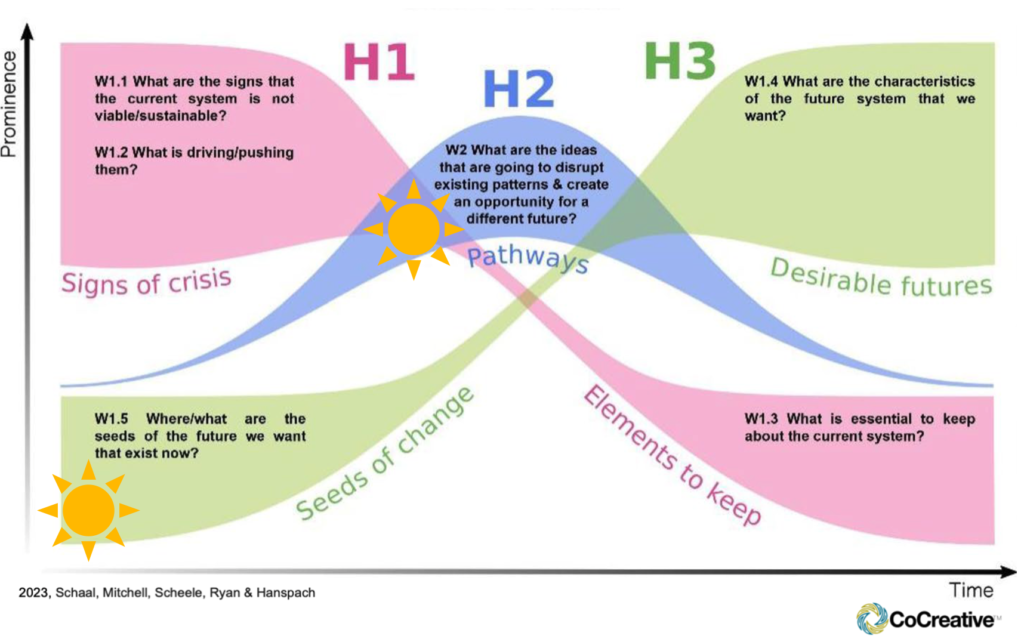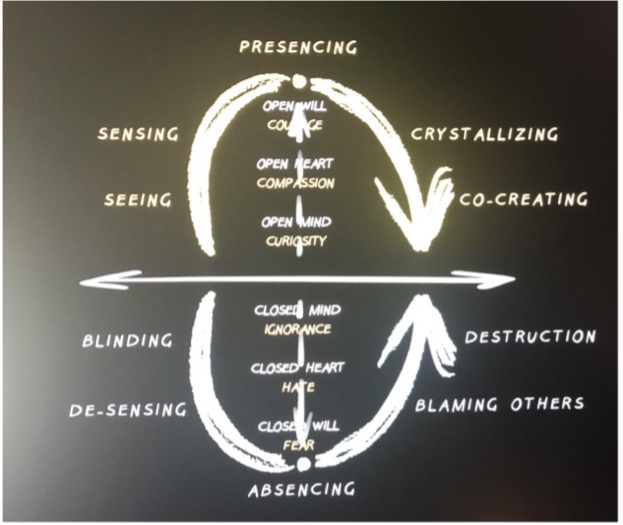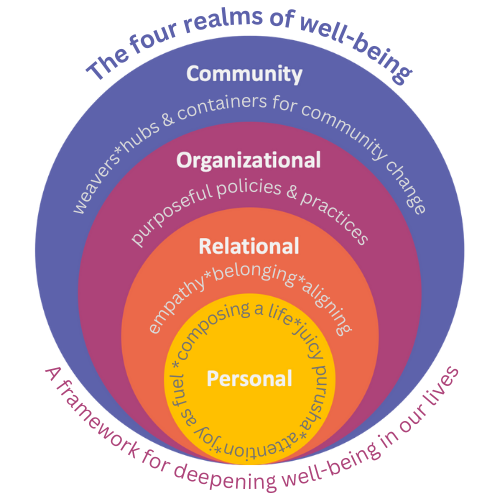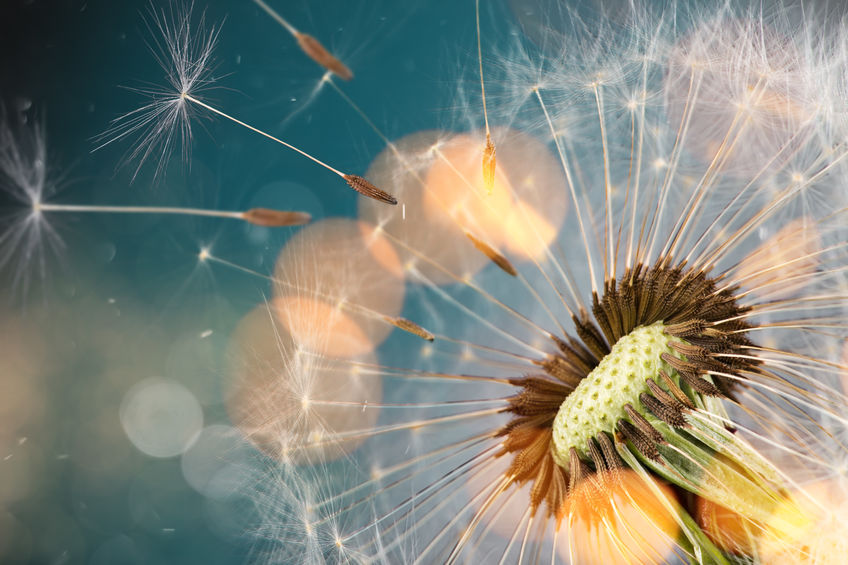This blog is inspired by a Well-Being for All webinar co-hosted by CoCreative and the Academy for Systems Change.
What does the future of our collective well-being look like, and in what ways is it already here? Too often, we focus on problem-solving for our current reality to the neglect of seeing where the world we want is already present. As we seek a better future, it can be life-enhancing to take a step back and elevate all that is already present.
Recently, a group of changemakers from around the world gathered in a virtual setting to explore this emergence. I was honored to co-host this exploration with CoCreative and the Academy for Systems Change as part of their Well-Being for All webinar series. Please join the ongoing conversation!
We begin with the 3 Horizons to tune our senses to perceive the ways in which the seeds of the future we seek are already in our midst.

In Horizon 1, which can be thought of as the present moment through the next year, we ask, Where/what are the seeds of the future we want that exist now? (W1.5) In Horizon 2, which can be seen as the next 3 – 5 years, we ask, What are the ideas that are going to disrupt existing patterns & create an opportunity for a different future. (W2)
We then invite in an awareness that we each have a choice of how we respond to current conditions in our world. The Presencing Institute posits there are three differing responses to the current disruptions playing out in all sectors and systems.

We can muddle through, close down, or open to co-sense and co-create the future – actualizing the future that wants to emerge. They note, “We can choose to operate from a closed mind, closed heart, and closed will, or we can choose to operate from an open mind, open heart, and open will… In essence, the difference is about a shift of the heart on the level of the individual and the collective.”
To anchor these approaches within well-being, we turn to the Four Realms of Well-Being, a framework I’ve been nurturing over the past few years as I work alongside community collaborations and nonprofit leaders.

Within each realm – personal, relational, organizational and community – we recognize that we are each on a learning path that is both shared and utterly unique. We can’t overlook the particularities of our own life experiences and perspectives that profoundly affect our day to day, and we invite in our differences of experience and ways of being in our approaches to well-being.
The Personal Realm | How do you cultivate space, grace & joy in your life?
Cultivating well-being in our personal lives can seem radical. Who has time to attend to self when the world needs such urgent care? Yet I believe it is a necessary, liberating antidote to a worldview that tries to keep us depressed, distracted, and disengaged.
“Living is an improvisational art,” wrote cultural anthropologist Mary Catherine Bateson in her seminal book, Composing a Life. We are continually adjusting to changing conditions in order live with authenticity and fulfillment. During our webinar, we explored three aspects of composing a life: juicy purusha, reclaiming our attention, and joy as fuel.
Juicy purusha is a term I coined to describe how we can remain grounded amidst the whirlwind of modernity. Based in yogic philosophy, Prakriti is everything that is changeable, like the weather, our thoughts, feelings and our body, and the socio-political world. Purusha is the immutable stillness that rests within each of us. Judith Lasater describes prakriti as a torrential rainstorm, and purusha as a warm room with a window. We can choose to be in the rainstorm – getting soaked, buffeted by wind and rain – or we can come inside, and watch the rainstorm from within a safe, cozy room. It’s our choice.
Reclaiming our attention Have you ever noticed that when you’re thinking about buying a red car you start to see red cars EVERYwhere? What we focus on influences our awareness. In this age of 24-7 media, biologist and author Robin Wall Kimmerer says it best: “Our attention has been hijacked by our economy, by marketers saying you should be paying attention to consumption, violence, political division. If we can reclaim our attention and attend to things that really matter, there a revolution starts.”
Joy as fuel In these times, many of us have wondered aloud, How could one be joyful in a moment like this? Yet joy is not a privilege. “Joy is the justice we give ourselves,” writes poet J. Drew Lanham in his beautiful poem of the same name. Joy is the fuel that stokes our inner fire to do the work we are called to do in this life. In Ancient Chinese Medicine, joy is the antidote to anxiety. And so we intentionally invite in delight.
The Relational Realm | How do you cultivate empathy and expansive belonging?
Being in right relationship with others – what Buddhists call “interbeing” – asks us to be in an ongoing practice of learning, reflection, and action. Core to this is cultivating the ability to understand and to share the feelings of another, what we often think of as empathy.
The Othering & Belonging Institute at UC Berkeley is leading an extraordinarily thoughtful and joyful approach to deepening empathy through bridging and belonging. “Belonging is both how you feel… like I can exhale and I’m safe, and at the group level and institutional level, I get to cocreate the thing I belong to,” says john a. powell, Director of the Institute.
Bridging are practices that help us to be in relation with people and groups that are dissimilar, while growing a greater inner awareness. In our deeply polarized and politicized landscape, we strive to build the “core muscles” to increase our empathy and acceptance of diverse peoples, values and beliefs. We strive to cocreate environments in which we may not all agree, but in which we all belong.
The Organizational Realm | In what ways are our structures, policies and practices evolving to support well-being?
Transformation begins from within, and yet we know that context matters. The structures, policies and practices within an organization can encourage or discourage well-being. Post-pandemic, millions of people are reassessing their relationship to their jobs, challenging longstanding assumptions about workplace norms.
The modern office was created after World War II, on a military model—strict hierarchies, created by men for men, with an assumption that there is a wife at home. There’s a growing realization that the model is broken; burnout in the nonprofit sector is but one example.
We’re seeing meaningful changes in organizations that are reimagining work in our modern times. These changes include: the 32-hour work week; paid parental/caregiver leave; sabbaticals/holiday hiatus/flexible leave policies; diverse board of directors; wage transparency; and fairness in hiring, pay, and promotions.
The Community Realm | Who are the weavers in your community?
To help ballast us through times of crisis, many of us turn inward, which can increase our sense of isolation and difference. And yet key to community well-being is fostering a sense of connectedness, something that the social sector excels at. We are the “weavers” – people who strengthen community by connecting people, organizations, and efforts.
“One of the things that really strikes me is that we’re all drowning in content, but what we need are containers for connection,” writes Casper ter Kuile, author and co-founder of the Sacred Design Lab.
Many of us worry at the increasing divisiveness within our communities and our society. However, a recent report by the Harwood Institute called Civic Virus found that, “Americans don’t feel polarized or antagonistic toward one another. They feel isolated and disoriented… And in a desperate search for acceptance and belonging.”
Through our work as weavers, we create the containers for connection in which belonging and bridging can happen. We’re the ones who host the open houses, rally responses to crises in the world, and corral folks to volunteer on trail days and at food kitchens. We weave the social fabric of our society, even as the conditions, opportunities and crises shift.
Exploring the Four Realms of Well-Being can help us reflect on the many ways in which the future we seek is in our midst. It invites us to grow the light, rather than to stay fearful and isolated within the challenges of our times. The Four Realms is an emergent framework, and I welcome your thoughts and impressions as we continue to foster the conditions that expand well-being for all.

Deb- you are such an inspirational thought leader. Thank you for your beautiful work that you are brining into the world.